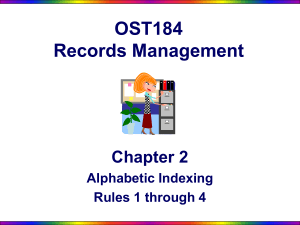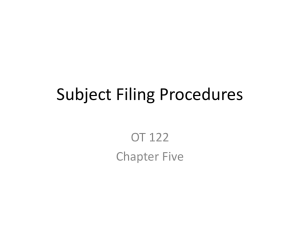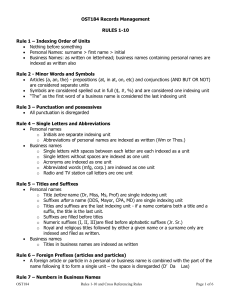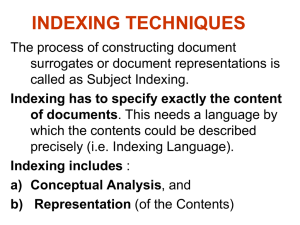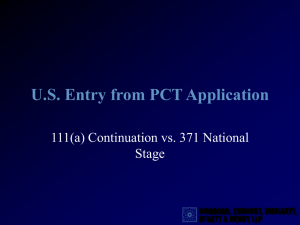Chapter 2 PPT
advertisement
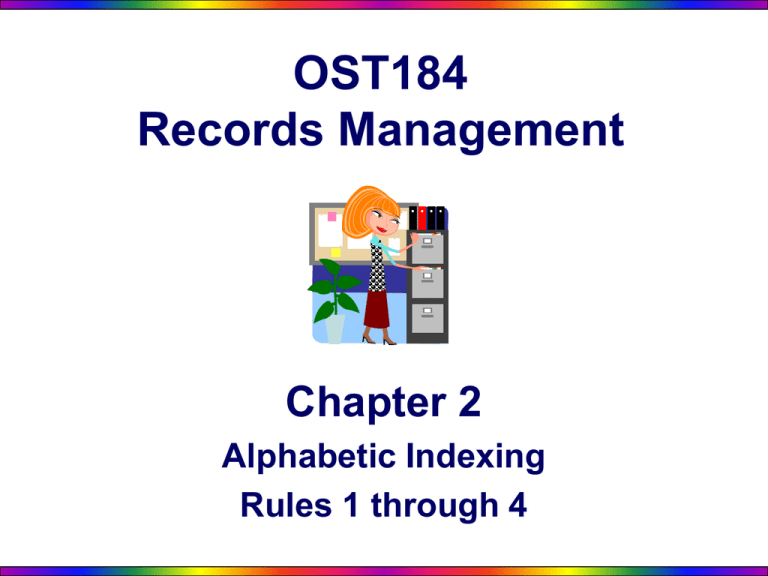
OST184 Records Management Chapter 2 Alphabetic Indexing Rules 1 through 4 Need for Alphabetic Order Records • Serve as the memory of an organization. • Help a business do business. • Help decision makers with the right information when it is needed. Filing Method (or Storage Method) • • • • Describes the way in which records are stored in a container. Alphabetic - most common method (Chapters 2-7) Subject - discussed in Chapter 8 Numeric - discussed in Chapter 9 Geographic - discussed in Chapter 10 Filing Rules The most important concept to remember when filing is that all filing is done to facilitate retrieving of information when it is needed. To retrieve information efficiently, a set of rules must be followed. − Different businesses have different needs for information retrieval. − Not every business follows a universal set of rules for alphabetic filing because the goals and needs of each business vary. − Without written rules for storing records, procedures will vary with time, changes in personnel, and oral explanations. Unless those who maintain the records are consistent in following storage procedures, locating records would not be possible. Steps for Storing Alphabetically • There are seven steps for storing alphabetically. • We will learn four of them in Chapter 2 as shown below. The other steps will be discussed in Chapter 6. 1. Indexing 2. Coding 3. Cross-referencing 4. Sorting Indexing Indexing – the mental process of determining the filing segment by which a record is to be stored. The filing segment is the name by which a record is stored. Indexing (cont’d) Careful, accurate indexing is perhaps the most exacting step in the storage procedure. Several terms are used with indexing: • Indexing units – the words that make up the filing segment • Key unit – the first unit of the filing segment • Indexing order – the next units following the key unit by which the placement of records if further determined Coding Coding is the act of physically assigning a file designation to records as they are classified. • Place a diagonal ( / ) between each word in the filing segment. • Underline the key unit. • Number each succeeding unit starting with 2, 3, 4, etc. 2 3 Personal Name Coded: Jane / T. / Shank 2 Business Name Coded: Longshanks / Eatery Coding Example - Personal Name Laura J. Huff • • • • Complete name is the filing segment HUFF is the key unit LAURA is the second unit J is the third unit Coding Example - Business Name Huff and Sons, Construction • • • • • Entire name is the filing segment HUFF is the key unit AND is the second unit SONS is the third unit CONSTRUCTION is the fourth unit Rule 1 - Indexing Order of Units A. Personal Names • Surname (last name) is the key unit • Given name (first name) or initial is the second unit • Middle name or initial is the third unit • If determining the surname is difficult, consider the last name written as the surname. Remember the rule – “Nothing comes before something” Examples of Rule 1A Rule 1 - Indexing Order of Units B. Business Names • Index as written using letterhead or trademarks as guides. • Each word in a business name is a separate unit. • Business names containing personal names are indexed as written. Examples of Rule 1B Complete together the “Rule 1 Self-Check” on pages 38-39. Rule 2 - Minor Words and Symbols in Business Names Articles, prepositions, conjunctions, and symbols are considered separate indexing units. • Articles: A, AN, THE • Prepositions: AT, IN, OUT, ON, OFF, BY, TO, WITH, FOR, OF, OVER • Conjunctions: AND, BUT, OR, NOR Symbols are considered as spelled in full. • Symbols: &, $, #, % (AND, DOLLAR or DOLLARS, NUMBER or POUND, PERCENT) When “The” appears as a first word of a business name, it is considered the last indexing unit. Examples of Rule 2 Complete together the “Rule 2 Self-Check” on pages 42. Rule 3: Punctuation and Possessives All punctuation is disregarded when indexing personal and business names. • Commas, periods, hyphens, apostrophes, dashes, exclamation points, question marks, quotation marks, underscores, and diagonals (/) Names are indexed as written. Examples of Rule 3 Complete together the “Rule 3 Self-Check” on pages 43. Rule 4 - Single Letters and Abbreviations A. Personal Names • Initials in personal names are considered separate indexing units. • Abbreviations of personal names and nicknames are indexed as they are written (Wm. Jos. Thos.) Rule 4 - Single Letters and Abbreviations B. Business Names • Single letters in business and organization names are indexed as written. • If single letters are separated by spaces, index each letter as a separate unit (ABC versus A B C) • An acronym (ARMA or GMAC) is indexed as one unit regardless of punctuation or spacing. • Abbreviated words (Mfg. Corp, Inc.) and names (IBM, GE) are indexed as one unit regardless of punctuation or spacing. • Radio and television station call letters are indexed as one unit. Examples of Rule 4 Complete together the “Rule 4 Self-Check” on pages 44. Cross-Referencing When a record is likely to be requested by any of several names, an aid called a crossreference is prepared. A cross-reference shows the name in a form other than that used on the original record, and it indicates the storage location of the original record. But…too many cross-references crowds the files and may hinder retrieval rather than help. Letter with Filing Segment and Cross-Reference Marked Cross-Referencing Unusual Personal Names When determining the surname is difficult, use the last name written as the key unit on the original record. Cross-Referencing Hyphenated Surnames With hyphenated surnames, a request for records could be in either of the two surnames. Note: Remember that punctuation is ignored.. Cross-Referencing Alternate Names When a person is known by more than one name, you need to make a cross –reference. Cross-Referencing Similar Names A variety of spellings exist for some names. A SEE ALSO cross-reference is prepared for all possible spellings. Cross-Referencing Compound Business Names When a business name includes two or more individual surnames, prepare a cross-reference for each surname other than the first. Cross-Referencing Abbreviations and Acronyms When a business is commonly known by an abbreviation or an acronym, a cross-reference is prepared for the full name. Pages 50-51 Complete together the “Rule 4” Self-Check and the “Rules 1-4” Self Check.
